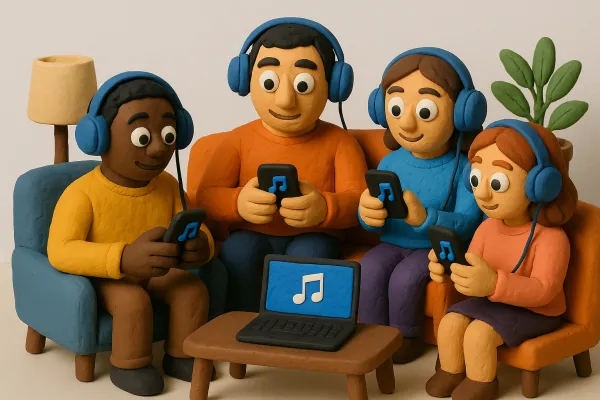Understanding How Much Money is 10000 Streams on Spotify: A Comprehensive Guide

If you're an artist on Spotify or just curious about how the streaming service compensates its musicians, you might be wondering how much money is 10,000 streams on Spotify actually worth. The payment system can be a bit confusing, with various factors affecting how much you can earn. In this article, we'll break it all down, from understanding the pay-per-stream rates to calculating your potential earnings and maximizing your profits.
Key Takeaways
- Spotify pays artists between $0.003 and $0.004 per stream, but this can vary.
- For 10,000 streams, artists can expect to earn approximately $30 to $50.
- Payouts are influenced by factors like listener location and subscription type.
- Free tier streams generate lower payouts compared to premium subscriptions.
- Using a Spotify royalty calculator can help estimate earnings, but results may vary.
Understanding Spotify’s Pay Per Stream Rate
Let's talk about how much Spotify actually pays for streams. It's not a straightforward answer, and there are a lot of things that affect the final number. We'll break it all down so you have a better idea of what to expect.
What Is The Average Pay Per Stream?
Okay, so here's the deal: Spotify's pay per stream rate isn't set in stone. It's more like a moving target. Generally, we're talking about a range of $0.003 to $0.005 per stream. But that's just an average. Some months it might be a little higher, some months a little lower. It really depends on a bunch of factors we'll get into.
Factors Influencing Pay Rates
So, what makes the Spotify pay per stream rate fluctuate? A few things:
- Subscription Revenue: The total amount of money Spotify makes from subscriptions and ads plays a big role. The more money they bring in, the more they have to distribute to artists.
- Distribution Agreements: The deals that Spotify has with different record labels and distributors can affect the payout rate.
- Fraudulent Streams: Spotify actively tries to detect and remove fake streams, which can impact the overall payout pool.
- Country of Origin: Where your listeners are located matters, as ad revenue and subscription prices vary by region.
It's important to remember that these rates are always subject to change. Spotify's business model is constantly evolving, and that can impact how much artists earn.
How Subscription Types Affect Earnings
Think about it: Spotify makes money from two main sources – Premium subscriptions and ads from free accounts. Premium subscribers generally contribute more to the revenue pool because they pay a monthly fee. So, streams from Premium accounts tend to be worth more than streams from free accounts. It's all about where the money is coming from. If you want to increase your music promotion and get more streams, you should consider this factor.
Calculating Earnings From 10,000 Streams
How Much Money Can You Expect?
Okay, so you've hit 10,000 streams on Spotify. Congrats! Now for the big question: how much money are we talking about? It's not a straightforward answer, but we can give you a reasonable estimate. Generally, 10,000 streams might earn you somewhere between $30 and $50. Keep in mind this is just a ballpark figure. Several factors can cause this number to fluctuate, which we'll get into.
Breaking Down The Numbers
Let's look at how this estimate is derived. Spotify's pay-per-stream rate is tiny, usually fractions of a cent. The rate changes, but it's often cited as being between $0.003 and $0.005 per stream. So, if we take those numbers and multiply them by 10,000, here's what we get:
- $0.003 x 10,000 = $30
- $0.005 x 10,000 = $50
Of course, this is before Spotify takes its cut, and before your distributor takes theirs. It's also before taxes. So, the actual amount landing in your bank account will be less.
Comparing Earnings Across Regions
Where your listeners are located makes a big difference. Streams from countries with higher subscription rates tend to pay more. For example, a stream from the United States or Sweden will likely be worth more than a stream from India or Mexico. This is because Spotify's revenue varies by region. Countries with more premium subscribers contribute more to the overall pot, which then gets distributed to artists. It's a global platform, but the economics are very local.
Think of it like this: Spotify has different "pots" of money for different regions. The size of each pot depends on how much revenue Spotify generates in that region. Your streams are essentially claiming a tiny piece of that pot. So, the bigger the pot, the bigger your piece will be.
Factors That Impact Spotify Payouts
Geographic Location
Where your listeners are located really matters. Spotify's revenue isn't the same everywhere. Streams from countries where people pay more for subscriptions bring in more money than streams from places with lower subscription fees. So, if you've got a lot of listeners in, say, the US or the UK, you'll probably see a bigger payout than if most of your fans are in countries where Spotify is cheaper. It's all about the listener's location and what they're paying.
Listener Demographics
Who is listening to your music also plays a big role. Are they mostly casual listeners, or are they dedicated fans who stream your songs repeatedly? Listener behavior impacts your earnings. For example, if a large portion of your streams comes from a smaller group of very active listeners, that can be a good sign. It means you've got a solid fanbase that's really into your music. Understanding your listener demographics can help you tailor your music and promotion strategies to keep them engaged.
Type of Account (Free vs. Premium)
This is a big one. Premium subscribers contribute way more to royalties than free users. Premium users pay a monthly fee, and a portion of that goes to artists. Free users, on the other hand, listen with ads, and the ad revenue is split up. So, if most of your listeners are on premium accounts, you're likely to earn more. It's simple: premium listeners mean more money for artists. The type of Spotify account makes a big difference.
It's important to remember that these factors often work together. You might have a lot of listeners, but if they're all in a low-revenue region and using free accounts, your payouts will be lower than if you had fewer listeners in a high-revenue region with premium subscriptions. It's all about finding the right balance and understanding where your audience is coming from.
How Spotify Counts Streams
It's not as simple as just hitting play! Spotify has specific criteria for what counts as a stream. Let's break it down so we can understand how those numbers rack up.
What Qualifies As A Stream?
To be counted as a stream, a listener needs to listen to a song for at least 30 seconds. This is pretty standard across the platform, whether it's music, podcasts, or even videos. If someone skips a song before that 30-second mark, it doesn't count towards your stream total. It's a bummer, but it keeps things (somewhat) fair. This is why it's important to make a good first impression with your music!
The Role Of Replays
Do replays count? Yes, they do! If someone listens to your song multiple times, each play that meets the 30-second requirement counts as a separate stream. There used to be concerns about people gaming the system, but Spotify has algorithms in place to detect and filter out bot activity or suspicious streaming patterns. So, while replays are great, genuine engagement is what really matters. It's all about building a fanbase that loves your music and wants to hear it again and again. You can check Spotify streaming numbers to see how your songs are performing.
Understanding Unique Listeners
While total streams are important, unique listeners give you a better picture of your reach. A unique listener is simply the number of individual people who have listened to your music. So, if one person listens to your song ten times, it counts as ten streams, but only one unique listener. Tracking unique listeners helps you understand how many new people you're reaching with your music, which is super valuable for growing your audience. It's not just about the quantity of streams, but also the quality of engagement and the size of your fanbase.
Understanding how Spotify counts streams is important for artists. It helps us to see how our music is performing and how we can improve our reach. It's not just about getting streams, it's about connecting with people and building a fanbase.
Who Gets Paid From Spotify Streams?
It's not just the artist who sees money from your Spotify streams. A whole ecosystem is involved, and understanding how the pie is divided is key. Let's break down who gets a slice.
The Artist's Share
Okay, so the artist is the main focus, right? Well, yes and no. The artist's share of royalties depends heavily on their agreements. Are they independent? Signed to a major label? These factors drastically change the percentage they actually pocket. Independent artists often have a better cut because they negotiate directly with distribution services. However, they also handle all the upfront costs. Artists signed to labels might get a smaller percentage, but the label usually covers production, marketing, and other expenses. It's a trade-off.
Role Of Record Labels
Record labels play a big role in the money flow. They invest in artists, and in return, they take a significant portion of the streaming revenue. This covers their investments in things like recording, promotion, and distribution. The exact split between the label and the artist is determined by their contract, and these contracts can be complex. Labels also often own the master recordings, which gives them even more control over the royalties. It's a business, after all, and labels are looking to recoup their investments and make a profit. Understanding the role of record labels is crucial for artists.
Distribution Services Explained
Distribution services act as the middleman between the artist and Spotify. They get your music onto the platform and handle the collection of royalties. Some popular distributors include DistroKid, TuneCore, and CD Baby. They typically charge a fee, either a flat rate per year or a percentage of your earnings. Each service has its own terms and conditions, so it's important to do your research and choose one that fits your needs. They handle the nitty-gritty of getting your music out there, so you can focus on creating. They also provide analytics and reports, so you can track your streams and earnings.
It's important to remember that the music industry is complex, and royalty structures are constantly changing. What you earn today might not be the same as what you earn tomorrow. Stay informed, read your contracts carefully, and don't be afraid to ask questions.
Using A Spotify Royalty Calculator
How To Use The Calculator
Okay, so you're curious about how much those streams are actually worth? That's where a royalty calculator comes in handy. These tools are all over the internet, and they're pretty straightforward to use. Usually, you just punch in the number of streams your song has racked up, and it spits out an estimated dollar amount.
The basic idea is that the calculator takes the average payout per stream and multiplies it by your total stream count.
It's not rocket science, but it gives you a general idea. You can typically find your stream counts on your Spotify for Artists account. Remember, though, it's just an estimate, not a guaranteed check.
Limitations Of Calculators
Don't get too excited about the numbers you see. These calculators are helpful, but they aren't perfect. They use average payout rates, and the actual amount you get can change based on a bunch of things. For example:
- Where your listeners are located (payouts vary by country).
- Whether your listeners have premium accounts.
- Your specific agreement with your distributor or label.
Think of a royalty calculator as a compass, not a GPS. It points you in the right direction, but it won't give you turn-by-turn directions to the exact amount of money you'll receive. It's a good starting point, but always double-check with your actual royalty statements.
Finding The Right Tools
So, how do you pick a good calculator? Well, look for ones that are updated regularly. Payout rates change, so you want a calculator that uses current data. Also, see if the calculator lets you adjust for different factors, like listener location or subscription type. The more customizable it is, the more accurate your estimate will be. Don't rely on the first one you find; try a few different ones and compare the results. It's all about getting the best possible estimate of earnings!
Maximizing Your Earnings On Spotify
Promoting Your Music Effectively
Okay, so you've got your music on Spotify. Awesome! But how do you actually make some decent money? It's not just about uploading and hoping for the best. We need to actively get those streams up. Promoting your music is key to increasing your visibility and, ultimately, your earnings. Think of it like this: no one can listen if they don't know you exist!
- Use social media to tease new releases.
- Create engaging content around your songs.
- Run targeted ads to reach new listeners.
Engaging With Your Audience
Building a fanbase is super important. These are the people who will keep coming back to listen to your music, share it with their friends, and generally support you. It's not just about getting streams; it's about building a community.
Treat your fans like friends. Respond to comments, ask for their opinions, and make them feel like they're part of your journey. A loyal fanbase is worth way more than a bunch of random streams.
- Respond to comments and messages.
- Host Q&A sessions on social media.
- Create exclusive content for your top fans.
Leveraging Social Media
Social media is your best friend when it comes to promoting your music. It's where people discover new artists, share their favorite songs, and connect with the musicians they love. We need to use it to our advantage. Think about music promotion as a way to connect with your audience.
- Share snippets of your music on TikTok and Instagram.
- Run contests and giveaways to increase engagement.
- Collaborate with other artists and influencers to reach new audiences.
If you want to earn more from your music on Spotify, there are some smart ways to do it. Start by promoting your songs on social media and engaging with your fans. Also, consider creating playlists that include your music along with other popular tracks. This can help you reach new listeners. For more tips and tricks on boosting your Spotify earnings, visit our website today!
Wrapping It Up
So, there you have it! When you break it down, 10,000 streams on Spotify can land you somewhere between $30 and $50, depending on a bunch of factors like where your listeners are and what kind of accounts they have. It’s not exactly a goldmine, but every little bit helps, right? If you’re an artist, knowing this can help you set realistic goals and maybe even inspire you to get creative with your music promotion. Just remember, building a fanbase takes time, so keep pushing your tunes and don’t get discouraged. Happy streaming!
Frequently Asked Questions
How much does Spotify pay for 1,000 streams?
Generally, Spotify pays around $4.37 for every 1,000 streams. However, this amount can change based on various factors.
Can I check how many streams my song has on Spotify?
Yes! If you are an artist, you can see your stream counts in your Spotify profile. Listeners can find this info in the 'Plays' section on the desktop version.
How much can I earn from 10,000 streams on Spotify?
For 10,000 streams, an artist can expect to earn between $30 and $50, depending on the pay rate.
What factors affect Spotify payouts?
Payouts can be influenced by location, the type of listener account (free or premium), and the demographics of the listeners.
What is considered a stream on Spotify?
A stream is counted when a song is played for at least 30 seconds on Spotify.
Who receives the money from Spotify streams?
The money goes to various parties, including the artist, record labels, and distribution services, depending on their agreements.





